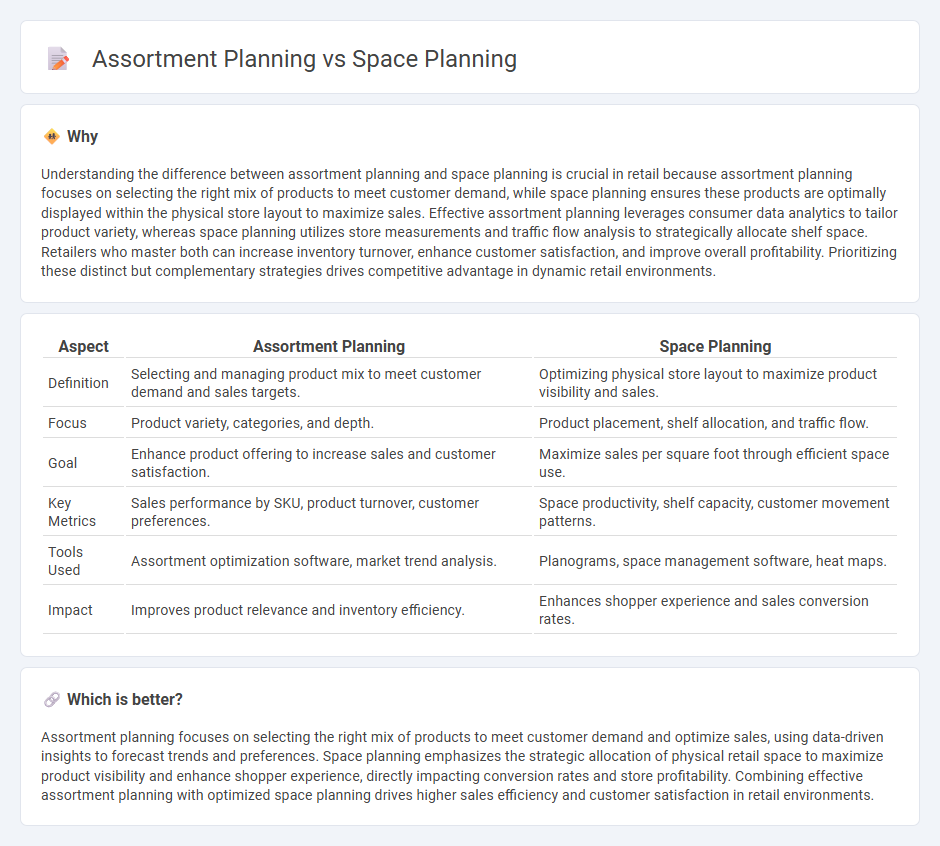
Assortment planning focuses on selecting the right mix of products to meet customer demand and maximize sales, while space planning optimizes the physical layout of merchandise to enhance product visibility and shopping experience. Effective retail strategies integrate both to balance inventory variety with efficient store design, directly impacting profitability and customer satisfaction. Discover more about how these planning processes drive retail success.
Why it is important
Understanding the difference between assortment planning and space planning is crucial in retail because assortment planning focuses on selecting the right mix of products to meet customer demand, while space planning ensures these products are optimally displayed within the physical store layout to maximize sales. Effective assortment planning leverages consumer data analytics to tailor product variety, whereas space planning utilizes store measurements and traffic flow analysis to strategically allocate shelf space. Retailers who master both can increase inventory turnover, enhance customer satisfaction, and improve overall profitability. Prioritizing these distinct but complementary strategies drives competitive advantage in dynamic retail environments.
Comparison Table
| Aspect | Assortment Planning | Space Planning |
|---|---|---|
| Definition | Selecting and managing product mix to meet customer demand and sales targets. | Optimizing physical store layout to maximize product visibility and sales. |
| Focus | Product variety, categories, and depth. | Product placement, shelf allocation, and traffic flow. |
| Goal | Enhance product offering to increase sales and customer satisfaction. | Maximize sales per square foot through efficient space use. |
| Key Metrics | Sales performance by SKU, product turnover, customer preferences. | Space productivity, shelf capacity, customer movement patterns. |
| Tools Used | Assortment optimization software, market trend analysis. | Planograms, space management software, heat maps. |
| Impact | Improves product relevance and inventory efficiency. | Enhances shopper experience and sales conversion rates. |
Which is better?
Assortment planning focuses on selecting the right mix of products to meet customer demand and optimize sales, using data-driven insights to forecast trends and preferences. Space planning emphasizes the strategic allocation of physical retail space to maximize product visibility and enhance shopper experience, directly impacting conversion rates and store profitability. Combining effective assortment planning with optimized space planning drives higher sales efficiency and customer satisfaction in retail environments.
Connection
Assortment planning determines the optimal product mix by analyzing consumer demand, seasonal trends, and sales data to maximize revenue and customer satisfaction. Space planning allocates physical shelf and store space according to the assortment plan, ensuring high-margin and high-turnover products receive prominent displays. Coordinating assortment and space planning increases inventory turnover, reduces stockouts, and enhances the overall shopping experience in retail environments.
Key Terms
Planogram
Space planning optimizes the physical layout of retail shelves to maximize product visibility and customer accessibility, while assortment planning focuses on selecting the right mix of products to meet customer demand. Planograms serve as a visual tool that integrates both strategies by detailing the precise placement and quantity of each product on store shelves. Explore how leveraging planograms can enhance retail performance through better inventory management and shopper engagement.
SKU Rationalization
Space planning optimizes retail shelf layouts to maximize product visibility and sales potential, while assortment planning selects the optimal mix of SKUs to meet consumer demand and profitability goals. SKU rationalization plays a critical role by identifying underperforming or redundant products, enabling retailers to streamline inventories and allocate space more efficiently. Explore more about how integrating SKU rationalization enhances both space and assortment planning for retail success.
Category Management
Space planning in Category Management involves allocating physical retail space to optimize product positioning and maximize sales per square foot. Assortment planning centers on selecting the right mix of products to meet customer demand, taking into account factors like seasonality, trends, and local preferences. Discover how integrating space and assortment planning drives superior category performance and enhances shopper satisfaction.
Source and External Links
What is Space Planning in Facilities Management? | ServiceChannel - Space planning involves organizing physical spaces to optimize their use, align with strategic goals, improve workflow and productivity, and ensure occupant health and safety through needs assessment, layout design, consultation, implementation, and evaluation.
Space Planning Basics - introduction for architectural design - Space planning includes organizing spaces using various spatial organizations (centralised, linear, radial, clustered, grid), considering flow, access, proportions, and connections between spaces to create comfortable and functional environments.
5 Steps to Effective Space Planning - HubStar - Effective space planning in 2025 focuses not just on efficiency but on creating work environments that support business objectives and employee needs, adapting to post-pandemic office attendance patterns and emphasizing effectiveness over density.
 dowidth.com
dowidth.com